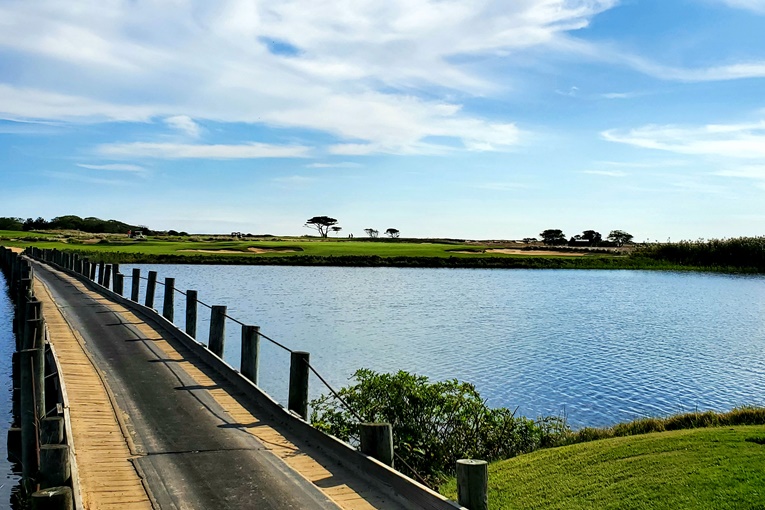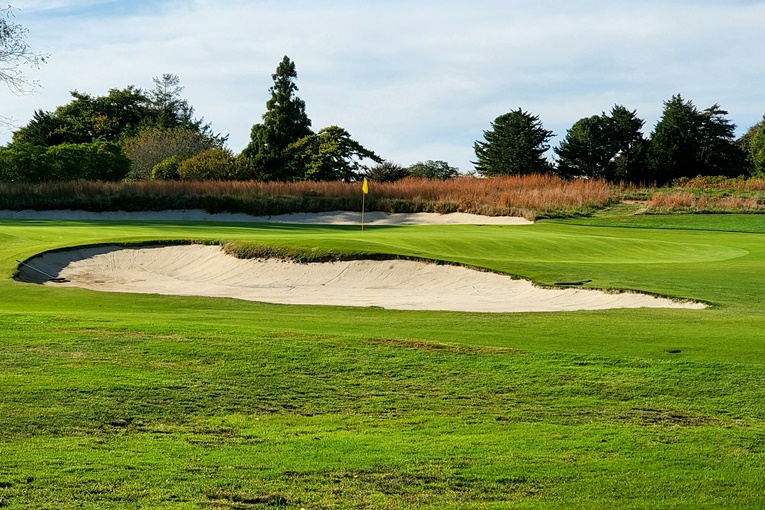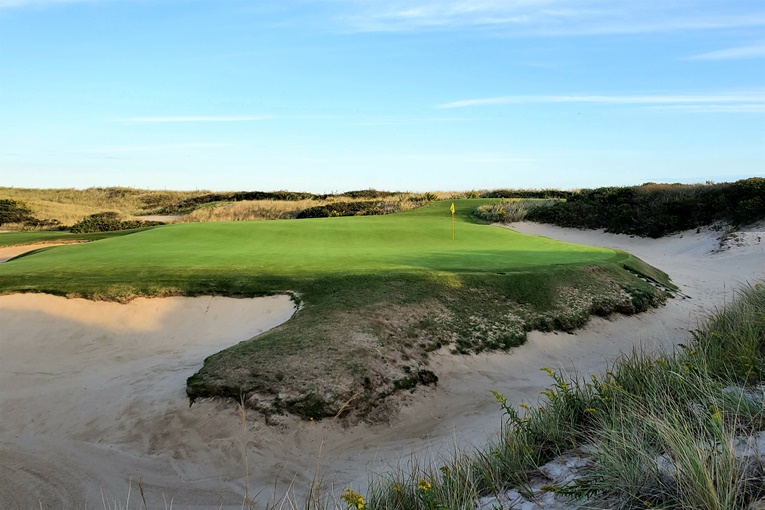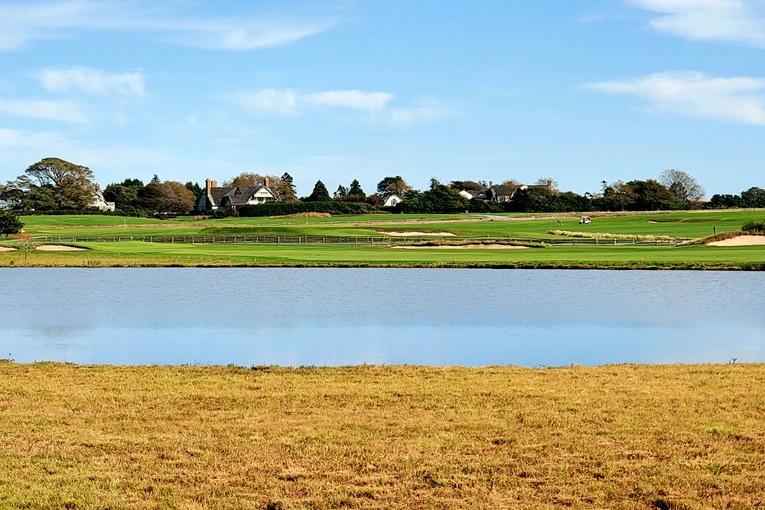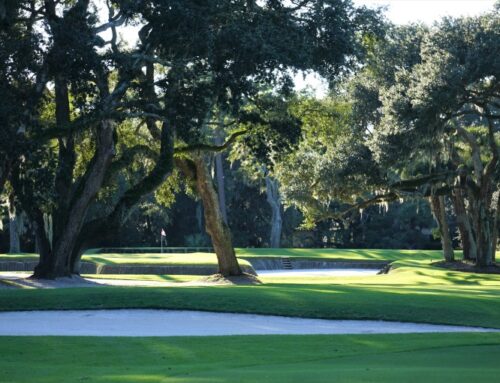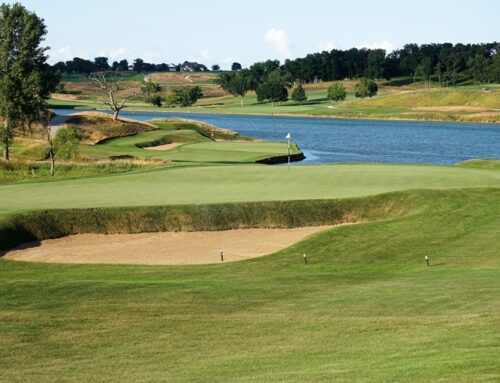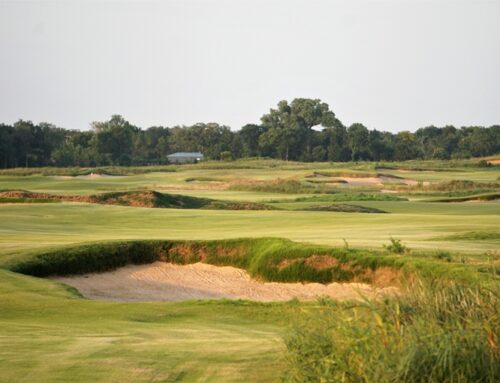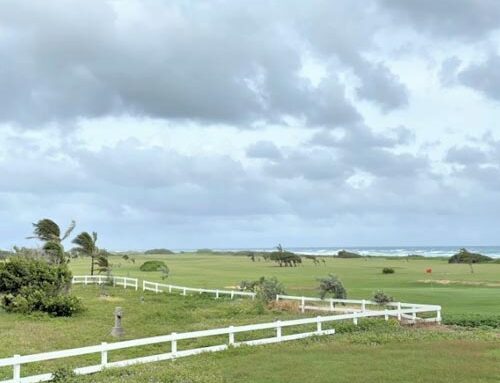The Maidstone Club
New York, United States of America
Green Keeper: John Genovesi

Maidstone’s coastal setting makes it a standout in North America. Beyond that, though, its presentation is also unique compared to many United Kingdom links whose dunes are smothered by coastal grasses. As a result, Maidstone enjoys a sandy, rich texture virtually unmatched in world golf.
A renewed sense of Willie Park Junior and his contributions to architecture has emerged this century. His work at Sunningdale Old in 1899 and Huntercombe in 1901 had a profound influence on many subsequent architects, including Hugh Alison, J.F. Abercromby and Sir Guy Campbell. After seeing Huntercombe in 1901, Walter Travis wrote in Golf Illustrated that it was:
‘…easily the best laid out links I have ever played over anywhere. There, in order to negotiate the round properly, you must be a master in the art of both scientific slicing and pulling, and be able to get the full measure of every conceivable stroke that occurs in the game, or else can be subject to some penalty – in short, every shot has to be played for all its worth. That is GOLF.’
Travis’s remarks sum up Maidstone as well, though Park didn’t design Maidstone for another twenty-one years. In fact, around the world in 1922, Park may well have been the architect of choice. For instance, he had recently completed Woodway Country Club in Connecticut, having been selected ahead of Donald Ross, A.W. Tillinghast and Seth Raynor.
Just how far has an appreciation for Park come in recent times? One example occurred at Meadowbrook outside of Detroit, when it elected in 2014 to unify its Golden Age course under Park’s design style. That’s saying something because Donald Ross had also worked there, and if the club had wanted to play the ‘name game’, it might well have gone the route of Ross. Instead, architect Andy Staples toured Park’s work in England as well as here at Maidstone to learn all he could about Park’s design ethos. As a result of Staples’s ‘retrovation’, Meadowbrook has never been more popular and in demand, highlighted by some scintillating Park influenced greens.
While at the height of his powers, Park was given his finest piece of property in North America when Maidstone acquired the 80 acres of the Gardiner Peninsula in 1922. The south end is framed by a 1,000 yard stretch of sand dunes with the Atlantic Ocean on the other side and the soil is sandy throughout. Today’s fourth green through the fifteenth reside on this thrilling parcel. No other architect at Maidstone ever had this coastal property at his disposal, from Willie Dunn who laid out a rudimentary seven hole course for the club in 1891 to Seth Raynor who drew up re-design plans in 1921.
Park’s routing on the 80 acres on Gardiner’s Peninsula and the other 50 acres is masterful as he introduces numerous forms of hazards at all sorts of angles to the player, including a marsh, Hook Pond, sand dunes, beach grass, reeds, well placed bunkers, and out-of-bounds. With such a variety of hazards, Maidstone reminds one of famed Royal North Devon in England. Additionally, his routing bore in mind the ever present wind and no three holes head in the same direction. Many holes elbow one direction or another.
Having won The Open in 1887 and again in 1889, Park was a world class player with a keen appreciation for how to challenge the golfer. One skill that he particularly admired was the art of putting and few courses can compete with the imaginative green contours he created here, highlighted by a slew of greens with dramatic false fronts including the first, second, third, sixth, tenth, thirteenth and fourteenth holes. The putting surfaces are central to the challenge for the ace player at Maidstone and Greenkeeper John Genovesi has maintained them for the past nine years in a fast and firm manner that would please Park to no end.
Indeed, Genovesi’s arrival in 2010 was well-timed as the club shortly thereafter extended an offer to Coore & Crenshaw to restore their course. Coore & Crenshaw’s desire to beat back the brush and undergrowth, return width to the playing corridors, re-establish Maidstone’s coastal roots and expand the putting surfaces to the green pad edges were vital things with which Genovesi concurred. From Coore & Crenshaw’s perspective, they saw the opportunity to increase playing interest for all level of players and as always, they sought to make their own involvement ‘invisible’, meaning Maidstone would only be thought of as a Park design from the Golden Age.
Having said that, it is vital to give a tip of the hat to Coore & Crenshaw and their crew for what they accomplished. Toby Cobb ran the project day-to-day and Jeff Bradley and Dave Zinkand were there throughout. Additionally, Dave Axland and Quinn Thompson joined in from time to time. A tremendous amount of time and energy was expended pulling back the brush and thicket and exposing the glorious natural landforms and dunescape. Many prominent features had been covered up and with the work done, the course once again enjoys a fabulous panoply of colors and textures.
The last aspect – recapturing Park’s greens – is a subject matter worthy of great attention. In 2010, the eighteen greens measured 81,318 square feet, or an average of 4,518 square feet per green. In 2019, the greens measure 118,637 square feet for an average of 6,591 square feet. Think about that – that’s an increase of 46%! Statistically, that is quite dramatic but the end results might be even more startling because so many fantastic contours were uncovered. In the process, numerous perimeter hole locations have been reintroduced, many of which happen to be among the greens’ most vexing. To say it is a ‘new’ course would be an overstatement but many of its members are stunned by the number of ‘new’ hole locations that they never recall experiencing.
Bill Coore, who knows a thing or two (!) about building great greens, has this to say, ‘Maidstone enjoys extraordinarily gifted greens as they are both beautifully artistic and still work well for golf. That is a very hard thing to pull off yet Park produced a set of greens that feature the exact right combination of contours and elevation changes for a site with that amount of wind. The greens are perfect for that site, which is something that only a limited number of courses can claim.’
We highlight these exceptional greens as we tour the course below but here is the point: Before the restoration, critics judged Maidstone based on its coastal holes, which are alarmingly wonderful but not many in number. To the author, the more appropriate way to view the course now is one whereby all eighteen holes are unified by virtue of their remarkable greens. Whether the target (a.k.a. the green) is by the ocean or inland is immaterial as regardless, the player is given something beguiling to do, each and every hole. Park’s engrossing greens tie the course together and the golfer needs to have his wits about him from the moment he tees off.
Holes to Note
First hole, 425 yards; What may seem like a straightforward start can turn into anything but! A cornerstone design tenet of Golden Age designs is that the golfer is given room off the tee with the screws tighten the closer he gets to the green. That’s exactly what occurs here and Park was a master at it because he could build outstanding greens. Over time, the good player realizes that where he places his ball in the fairway can be advantageous to certain hole locations and that being slightly out of position on one’s approach shot has consequences.
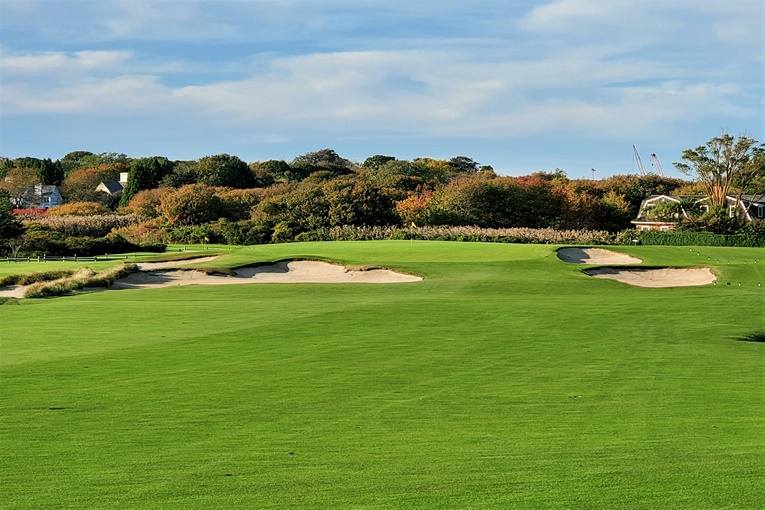
Flowing downhill, the expansive 1st fairway instills confidence that the perched green can quickly destroy.

Though the green measures nearly 6,700 square feet, the effective area for hole locations is only half that, courtesy of the dramatic false front and soft sides. A ball with too much spin can hit ten paces onto the green and finish well off. As at Pinehurst No. 2, the process begins of examining the golfer’s mental strength.
Second hole, 560 yards; An advantage that the Golden Age architects enjoyed over modern ones is that they could incorporate out of bounds into their designs. In today’s litigious society, that is less likely. Take the second where a road parallels the hole along the left from tee to green. Park made no effort to shield the golfer’s eye from it (though obviously less traveled then, it was nonetheless out-of-bounds). In addition, out-of-bounds hems in the hole from the right but Park angled the green so as to best accept an approach from the right edge of the fairway. Given the same bit of property, a modern architect would almost assuredly elect to ‘hide’ the road with artificial containment mounds (thus reducing a psychological terror of the hole) and would not tempt the golfer to seek the better angle to the green by playing out to the right.
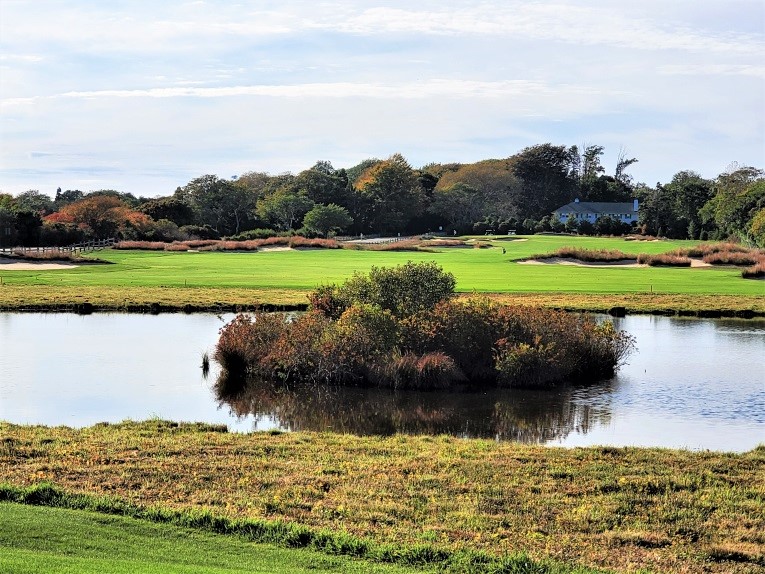
Out-of-bounds left and right with hazards everywhere – good luck.
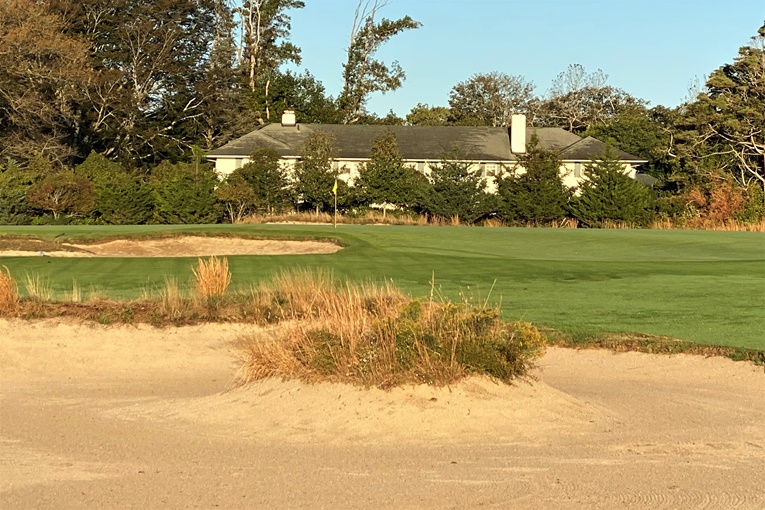
Similar to the Road Hole at St. Andrews, no joy is derived from playing up the left of the hole. Better to …

… aim away from the flag on one’s second and approach the shallow green from the right. Coore & Crenshaw expanded this angled green by over 65% (!) and in so doing, re-introduced nearly 10 lost perimeter hole locations. The need to lay up to the proper place in the fairway is more acute now than ever.
Third hole, 410 yards; One of a handful of straight holes on the course, Park created interest at the green with a false front as well as a rise in the middle of the green. Whether downwind or into it, the optimal approach is often along the ground. Willie Dunn’s original seven holes were mostly to the right of this fairway, and Dunn’s efforts account for the 1891 underneath the club’s whale logo. None of Dunn’s features are included in today’s 1922 course that was built during the height of the Golden Age.
Fourth hole, 240/175 yards; The fourth transitions the golfer onto the property’s seaside portion. The tee itself is in the middle of Hook Pond and the author wishes he knew more about what was required to build it. In a moment of rare, open hostility (!) toward the player, Coore & Crenshaw created a tee near the third green, which turns this hole into a 240 yard monster. Obviously, the tee is used only under certain wind conditions but many Golden Age architects felt no remorse in asking for a three wood or driver to a one shot hole. Clearly, Coore & Crenshaw share a similar sentiment and to be fair, they expanded the green to nearly 10,000 square feet, making it the course’s largest target.
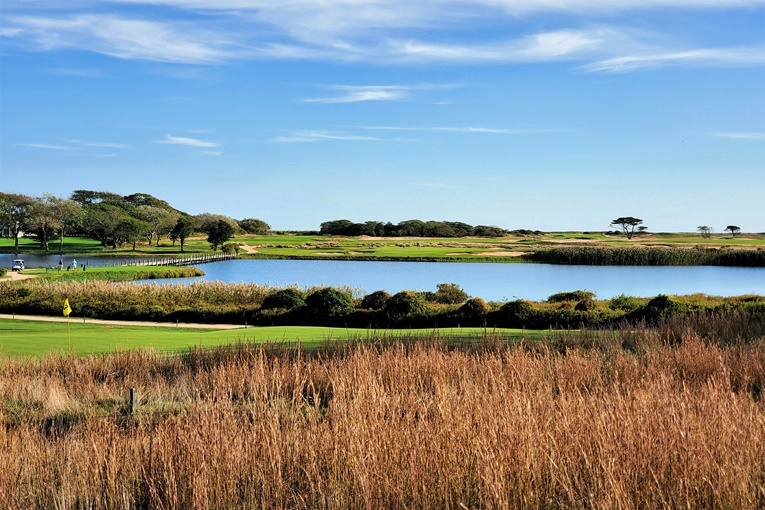
The view across the 3rd green with the 4th green in the distance. Coore & Crenshaw’s new back 4th tee is near the 3rd green and the nicest thing that the player may think about it is that it shortens the green to tee walk!
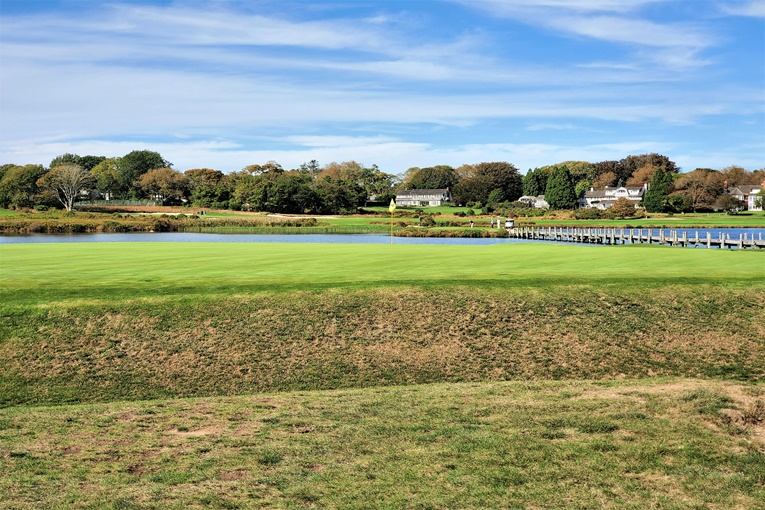
The sight of the water leads most golfers to reach for the longer club should indecision exist. And yet, should one go over, Park’s six foot deep trench is no bargain from which to recover.
Fifth hole, 325 yards; The author considers Maidstone to be one of the world’s most clever designs. Why? Because Park does everything possible to unsettle the golfer. To support that contention, let’s compare it to Pine Valley, a course with even more exposed sand. At Pine Valley, there are no drivable two shot holes or reachable three shotters. The goal is to hit the fairway, many of which are essentially ‘islands’, and then the green. Because the pressure is unrelenting, the author has always found the design to be surprisingly conducive to sliding into a good swing rhythm and maintaining it throughout the round. Put another way, there is no point in heroics as it is hopeless to attempt to overpower Pine Valley; no one is dumb enough to even try. At Maidstone, a big, well placed drive can make a full stroke difference on at least one third of its holes, including here, which can be driven under certain conditions. Does the golfer get wooed by such opportunities or does he possess the self-restraint to ‘swing within himself’ and manage his game? All gofers know the correct answer but Park makes it supremely tempting to act foolishly, overswing and play the hero. To know when to thrust and when to parry at Maidstone is an art form.
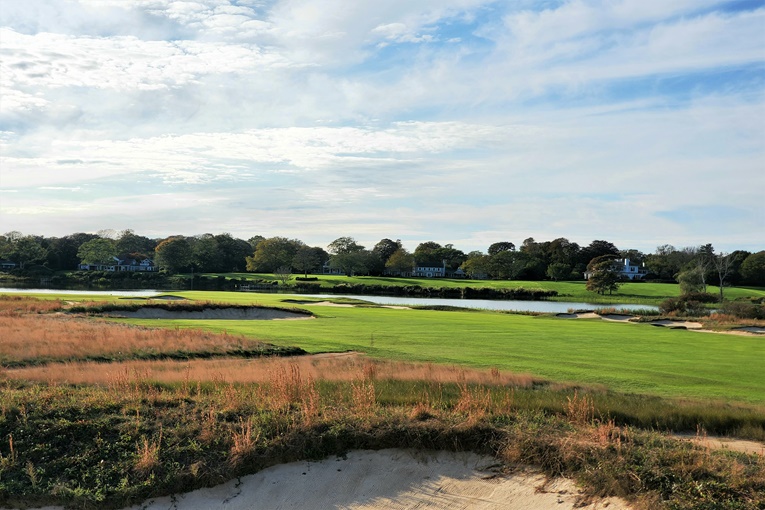
The sight of exposed sand increases and the coastal aspects of the property are amplified at the 5th with bunkers both left …
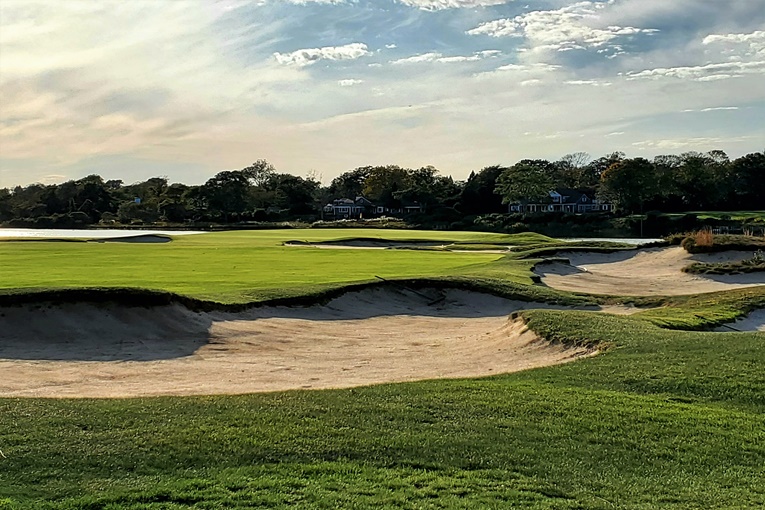
… and right. Numerous interesting hole location exist, including those tucked behind the front right bunker and along the elevated back edge.
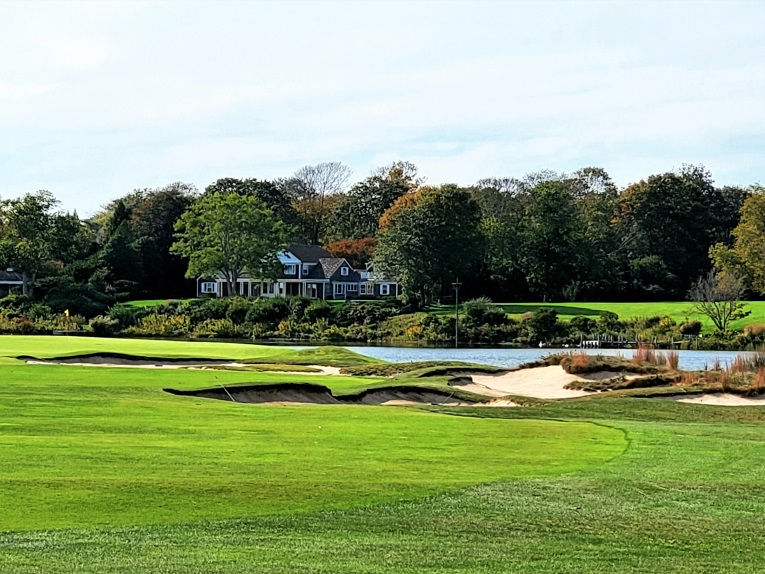
A highlight of Maidstone’s design is captured above, namely the variety and appeal of its green backdrops. In this case, back hole locations leave the golfer with the sensation that the flag is floating in Hook Pond.
Sixth hole, 405 yards; Coore & Crenshaw reintroduced a favorite design tenet here, namely what Max Behr referred to as ‘the line of instinct’ and ‘the line of charm.’ The line of instinct is the direct line between the tee and the flag and it is broken up by natural features. It represents the shortest distance between the tee and green and generally, the more the drive adheres to that line, the easier one’s approach. The line of charm differs as it is the safer play from the tee (away from the line of instinct) but alas, the approach is more difficult. Applying those principles here, the line of charm is to play safely left from the tee, though the approach then becomes problematic as Park cut a fierce bunker into a ridge front left of the green and built one of his all-time finest putting surfaces that cascades three feet from high left to lower right. The left bunker and green contour work in concert to thwart approaches from the left. Meanwhile, the line of instinct has the player carrying his tee ball longer over trouble for the sake of gaining the prefered playing angle from the right edge of the fairway for one’s second. Before Coore & Crenshaw’s arrival, the line of instinct didn’t exist as approach shots from the right weren’t obtainable due to unchecked growth of reeds and low-lying vegetation. With the reeds now gone, the sight of the flag acts as a siren and the playing angle is restored with the golfer needing to balance the desire for safety left against approaching from the right.

In fact, this pair of bunkers was uncovered by Coore & Crenshaw as they pulled back the reeds along the right.
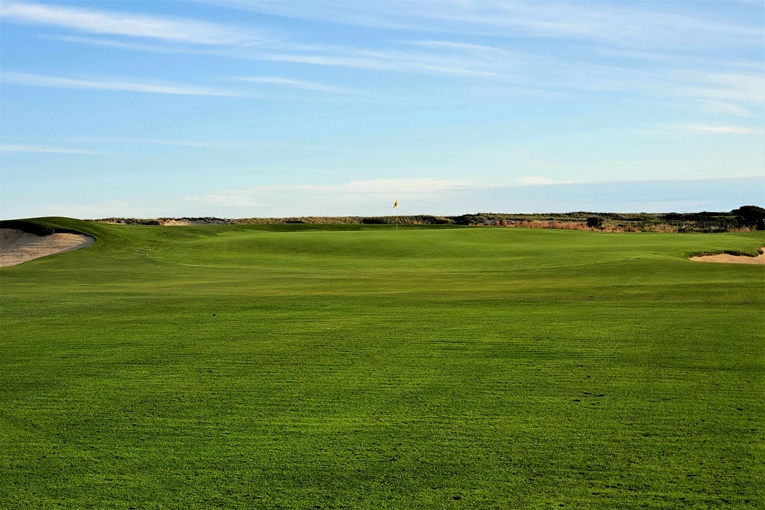
Maidstone’s greens are vastly underrated. To the author, they rank as a set among the two dozen or so finest in golf. Hats off to Park and Coore & Crenshaw – and to the club for being such a good custodian.
Seventh hole, 335 yards; Doglegs on tree-lined courses often devolve into nothing more than a straight shot off the tee followed by another straight one to the green with playing angles lost to tree growth. Maidstone stands at the other end of the spectrum, boasting fabulous diagonal playing angles off the sixth, seventh, sixteenth and seventeenth tees where the golfer must judge how much to bite off. Such tee balls epitomize ‘heroic’ architecture as a huge carry is often times greeted with a commensurately huge reward. With the Atlantic Ocean within 200 yards, the wind is an ever present issue and the proper line changes from morning to afternoon, making it a prime example of why Maidstone remains fresh to play year after year.
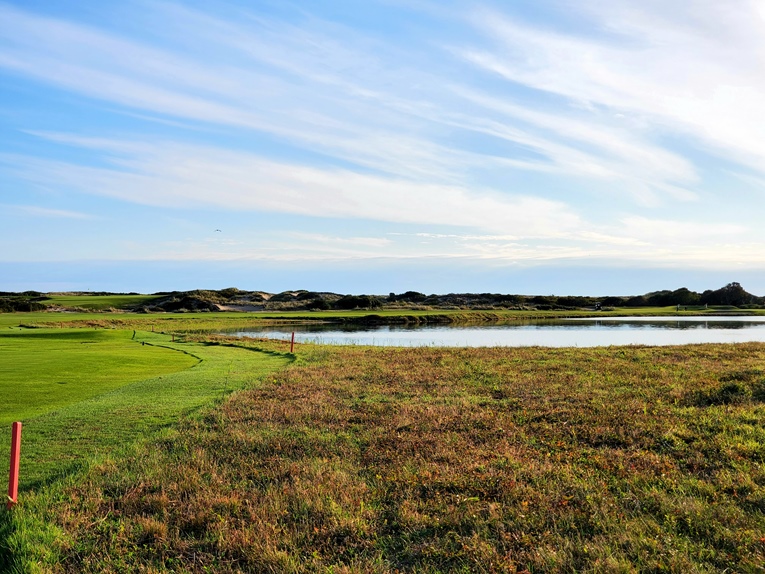
The second of four sensational diagonal tee balls where the line can vary ~70 yards depending on the wind.
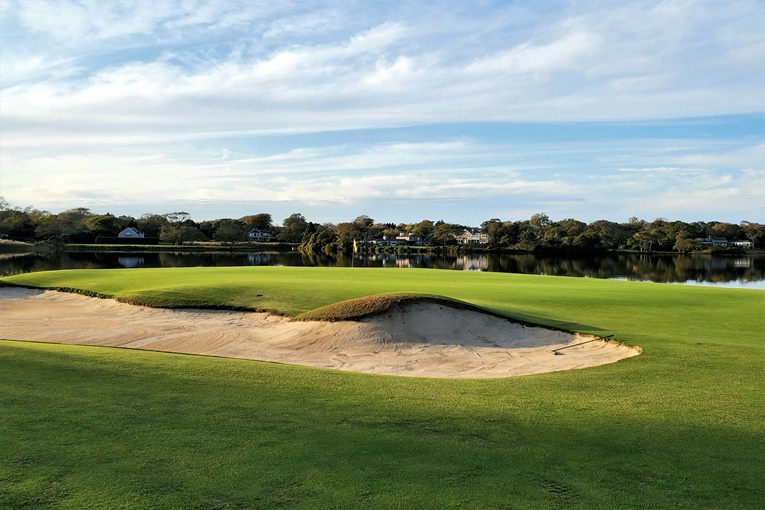
With Hook Pond right, plenty of approaches are nervously steered left into this awaiting bunker. Note how Genovesi and his crew diligently drape the putting surface toward the bunker, ensuring that the bunker plays even bigger than its footprint.
Eighth hole, 150 yards; One of Long Island’s most famous one shot holes is, ironically, not as Park designed it as his entire green was visible from the tee when the course opened. As exemplified at Sunningdale Old, his approach to course design eschewed blind approach shots while seeking to provide pleasure to the greatest number of people. Park passed away in 1925 and heavy storms throughout the 1930s and 1940s moved the sand dune inland and made the tee ball blind. An irate board member in the early 1960s leveled the sand dune with a tractor to the way it more or less is today, which is to say that the left half of the green is visible from the tee. A peek of the tip of the yellow flag is sometimes afforded just over the dune when the hole is set right. Though Park might disagree, today’s hole is a rare treat/thrill in American golf where the quest for perfect visuals and ‘fairness’ have contributed to blah designs for too long. At its highest level, the sport must contain mystery – and this hole does in spades.
Ninth hole, 415 yards; Few better courses to glean an understanding of minimalism than Maidstone. In general, minimalism refers to the desire of the architect to disturb as little dirt as required to provide good golf. Examples abound at Maidstone whereby an insignificant amount was moved tee to green other than the green site itself. Yet, the ninth is a fine example of minimalism too even though the architect moved more dirt here than any hole on the course. How can that be?! The concept of minimalism is to root the hole in nature. In this case, the 80 acres of the Gardiner Peninsula was mostly flat as it stretched from Hook Pond toward the Atlantic. Park, in a moment of brilliance, hollowed out an area parallel to the primary duneline and created a secondary, albeit faux, dunescape eighty yards inland. Such a long, shallow valley between dunes existed east of the clubhouse and perhaps Park took note of it. Regardless, in one fell swoop, Park created space for the glorious ninth fairway as curls between the two dunelines and gave the tenth its own voice. Both holes are great because he moved dirt, though it was so thoughtfully done that most people consider them to be the course’s most natural holes. Now that’s talent.
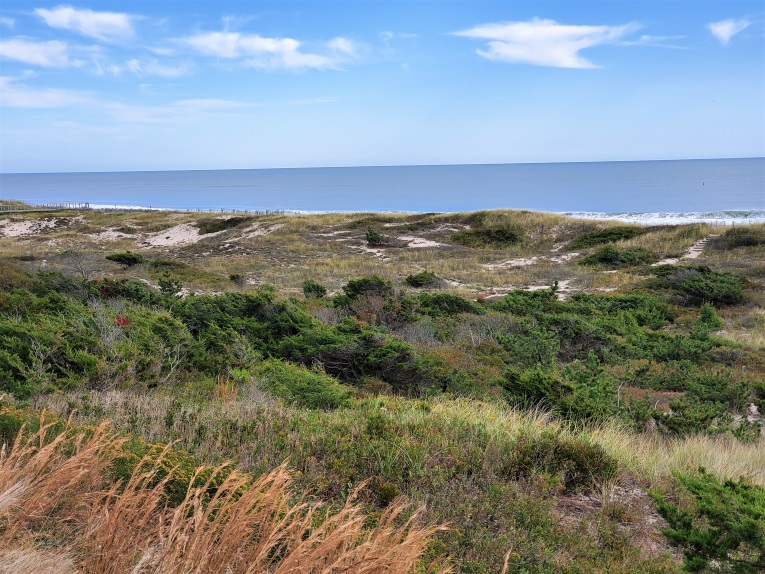
This low valley between two dunelines is east of the clubhouse and Park created something similar some 875 yards away on clubhouse’s other side when he …
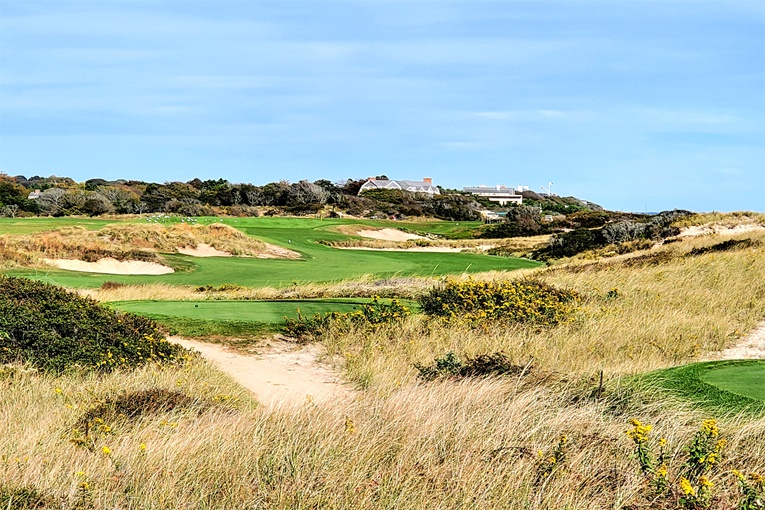
… hollowed out an area for the 9th fairway and moved the fill to the left to create what appears to be a natural dunescape. In this manner, he gave seclusion to the 9th and 10th holes respectively.
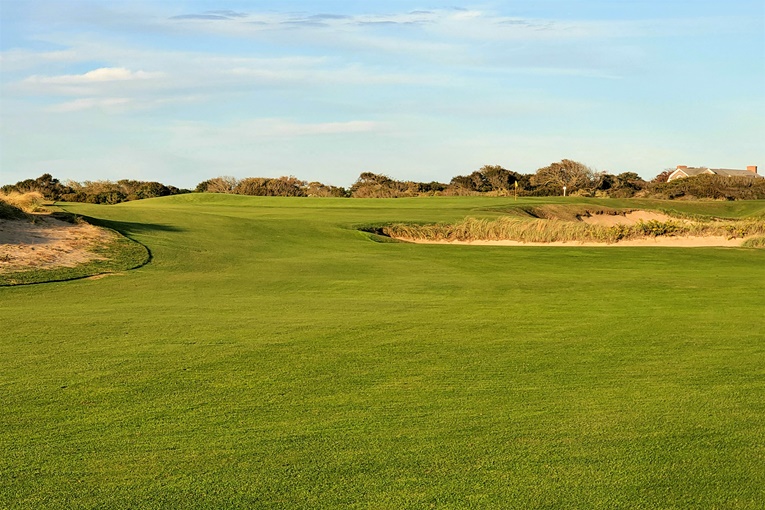
The cross bunker in the foreground slashes into the fairway 345 yards from the tee. Should the golfer not find the fairway, a pitch shot from short of it becomes a likely scenario for one’s third, another example of the accurate driver gaining an advantage at Maidstone. The real showpiece is the nearly 8,000 square foot, angled green rife with contour.

The ten foot deep ‘Yale Bowl’ becomes visible as one nears the green. The putting surface was expanded by over 50%, highlighted by the fact that its front left extends out of the photograph and today’s back right hole location wasn’t possible in 2010.
Tenth hole, 415 yards; Unlike Pebble Beach’s legendary ninth and tenth holes, the ninth and tenth here play in opposite directions. Which pair is better is up for debate but the dilemma faced here is materially different. The golfer may try to hold a three wood approach under the wind at the ninth and a few moments later, try to control his wedge from going over the tenth green (or vice versa). What makes this of note? Maidstone’s two holes are identical in length! For the past thirty minutes or so, since arriving at the eighth tee, the golfer has played what is arguably as fine a three hole stretch as exists in the United States. Fans of nearby Shinnecock Hills (14-16), Fishers Island (3-5), Pebble Beach (8-10), Cypress Point (15-17) and Augusta National (11-13) will each lobby for their cause but regardless, Maidstone is in the conversation.
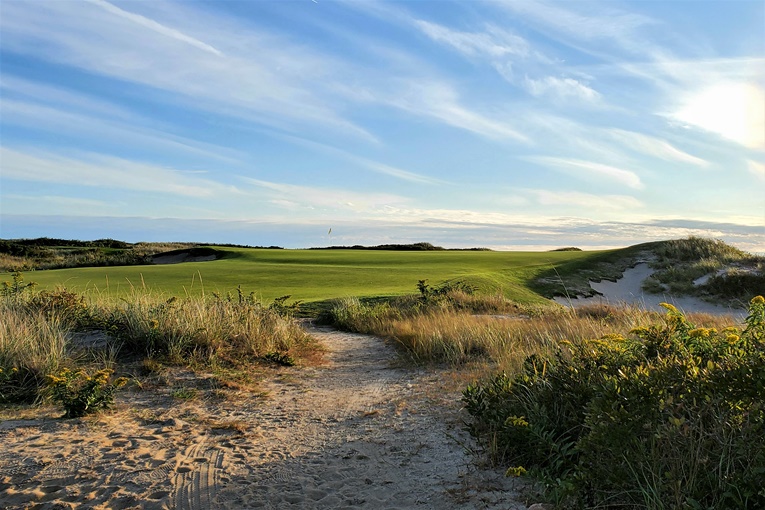
The 10th green sits on top of a hillock and its wicked green drops nearly six feet from back to front. Over is worse than short though …
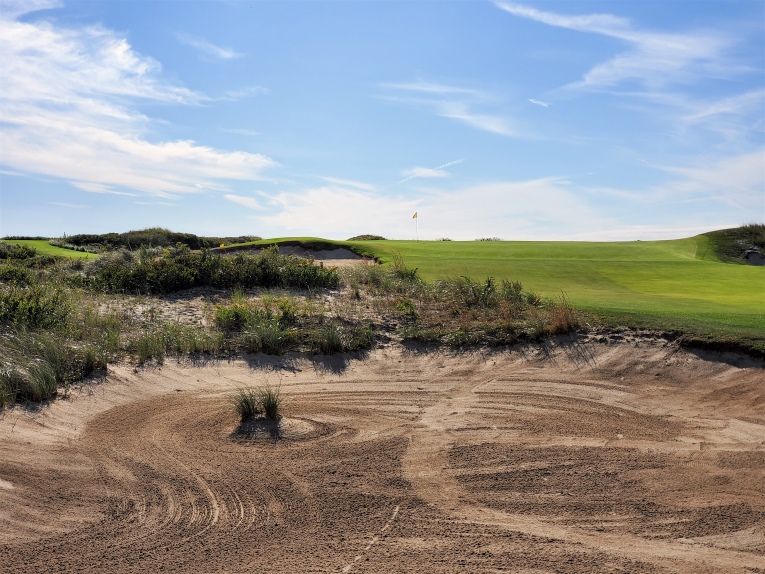
… as short leaves the unhappy prospect of a ball being repelled all the way back into this bunker.
Eleventh hole, 465 yards; Holes of enormous distinction were created in and amongst the dunes to the point where Bernard Darwin wrote that they were ‘the finest stretch I have ever seen in America.’ Park’s real challenge was to knock character into the other holes so that the overall quality of the course remained of a high standard. That he did, as freshly witnessed here and at twelve. Given the standard of architecture across all eighteen holes, realization starts to dawn that perhaps no architect could have rendered a finer course from this property than Park. Yes, there were bountiful natural features but there were challenges too including a multi-prong road and flattish land that had to be overcome. Pick your all-time favorite architect: could he have done better? The increasingly popular viewpoint is ‘no.’

The player who can shape the ball enjoys a marked advantage at Maidstone. A draw around the inside nest of bunkers does nicely at the attractively bunkered dogleg left 11th.
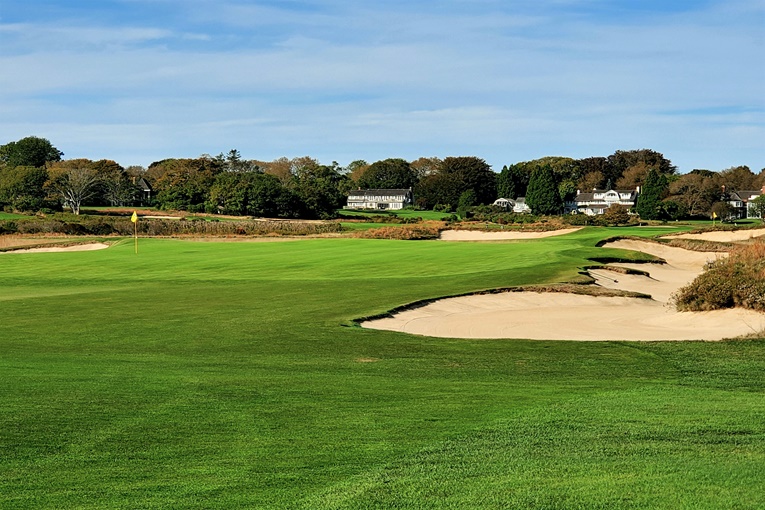
Anyone who enjoys the pleasures of golf in the United Kingdom will delight in figuring out where to land one’s approach on the fine fescue/bent mix fairway and watch it release onto the putting surface.
Twelfth hole, 185 yards; Similar to the eleventh, the twelfth might not endear the same passion as the dunes holes but nonetheless, is a very fine hole crafted by Park across ground devoid of much interest. The entrance to the green is an extension of the fairway, and Park built up and tilted the green so that the putting surface is in plain sight from the tee.
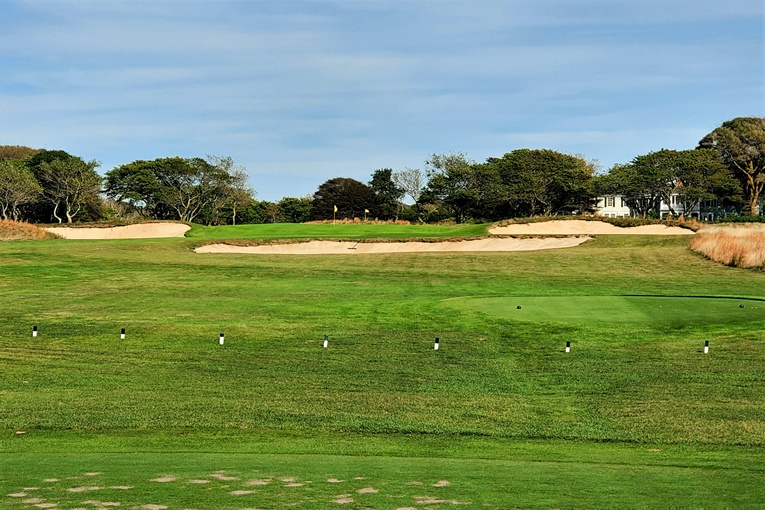
Though situated on flat land, the one shot 12th is visually appealing without appearing manufactured.
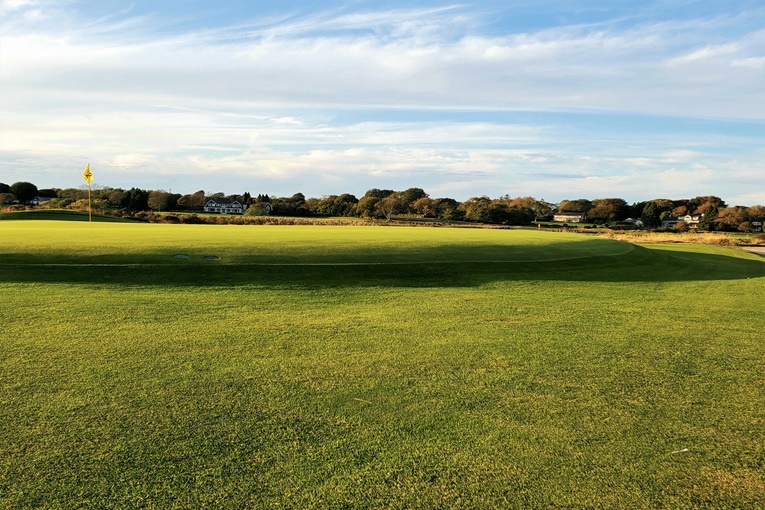
As seen from back right, the rear of the green is a peninsula with a drop off on all sides. Kudos to Genovesi and his crew for the delicate manner in which they fold the putting surface over the soft sides. Two holes later at the other one shotter on this nine, Park flared up the sides and back of the 14th green, in marked contrast to here. Variety is once again a hallmark of Maidstone’s greens.
Thirteenth hole, 535 yards; The chess game with Park continues at this long hole with playing angles galore, highlighting that Maidstone is about positioning the ball time and again to leave oneself with the best opportunity for the next shot. The members appreciate this component of the design better than the first time player, which helps to explain their undying loyalty to Park’s design. As with so many of the green complexes here, this one is angled to reward an approach shot from a particular spot in the fairway.

The long thirteenth transports the golfer into the dunes in a zigzag manner: first left, then right, then left to the green.
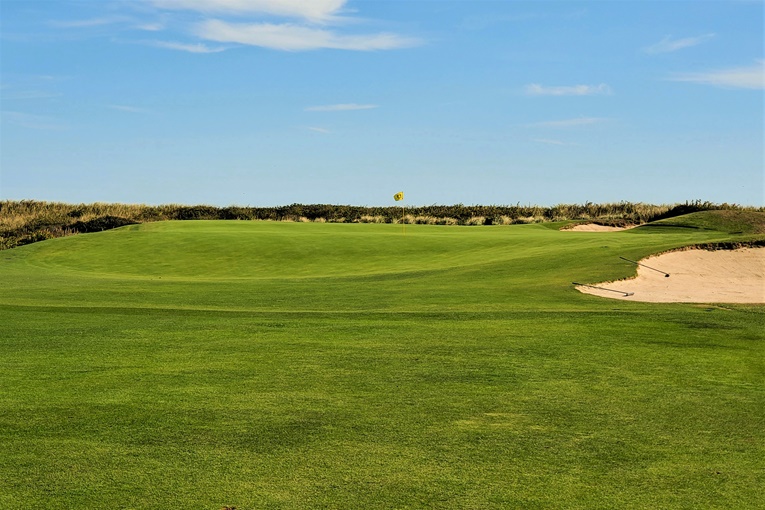
Another superlative false front simultaneously adds playing interest and an intense appreciation of the ground game. The tiger is satiated by the sight of a ball drawn by his 3 wood that bounds along the ground and clambers onto the top plateau. Meanwhile, the rest of us delight in a delicately played wedge whereby the ball lands beyond the false front and stays on top. All players regardless of their skill level find enjoyment and satisfaction.
Fourteenth hole, 150 yards; One of golf’s magical spots, this one shotter is set entirely in the dunes with the Atlantic Ocean as the backdrop. There is a tee and a green surrounded by scrub and bunkers – and that’s it. Park’s ‘less is more’ mentality shines through in such situations as too many other architects would have sought to make a statement. Not Park – let nature shine. Few holes compare, though the third at Kittansett comes to mind as a similar length hole ensconced in nature whose green also presents a ‘hit it or else’ proposition. Both holes quickly turn from friend to foe based on the wind.

The picture perfect (!) short 14th plays to a green ringed with trouble. Its natural sumptuous setting and clean lines lend the hole a regal quality.
Fifteenth hole, 495 yards; Coore & Crenshaw prefer building original designs to restoration work. A minor miracle is required to get them to agree to a restoration project, but once they do, they invariably place emphasis on improving the least distinguished holes, of which this was one as it was linear, cramped and devoid of strategy. The only necessity in 2010 was to hit the ball straight. What did Coore & Crenshaw do? First, they reintroduced the dunescape between the tee and fairway. After all, the tee sits high on a dune overlooking the Atlantic, so why not?! Second, they cleared back the thicket that closed in from both sides, making the hole less narrow and more multidimensional. Third, they introduced a central hazard left center in the fairway some 195 yards from the green. Fourth, they expanded the putting surface to the edges of the green pad and in so doing, uncovered some wonderful right hole locations in particular. It isn’t the best hole on the course but whatever it is, this 1/2 par hole is certainly no longer the least interesting. Job well done.

People once stood on the fifteenth tee, turned their backs to the course and looked at the ocean. Now the view inland is just as captivating.
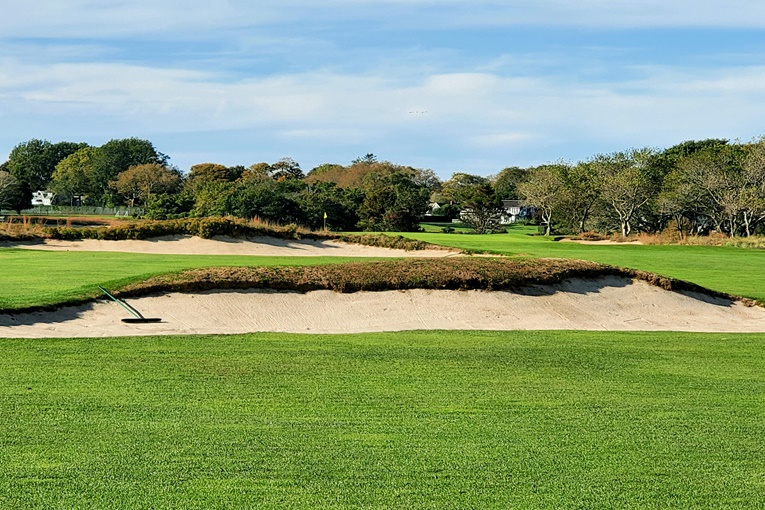
The 15th fairway is no longer clear sailing, thanks to these additions by Coore & Crenshaw. Such bunkers were not technically ‘restored’ as they never existed before but are an example of an architect judiciously adding a feature to account for how the game and equipment have changed over the past century.
Sixteenth hole, 485 yards; Park’s topnotch use of the natural hazards continues with a diagonal carry at the sixteenth tee. Picking the correct line varies from day to day with the wind by again as much as seventy yards (!) but the pressure is squarely on the tiger to cover the half par hole in four shots. This stress coupled with the uncertainty regarding the playing line preys on the golfer’s mind. Downwind, will he enjoy a short iron approach or will he tee three? There are six tee shots (here, the second, seventh, ninth, fifteenth and seventeenth) where the tee ball makes an enormous difference. These risk reward holes excel at just that: posing a stark risk but providing a commensurate reward. Just as many golfers bask in glory as are sent into a spiral of frustration.
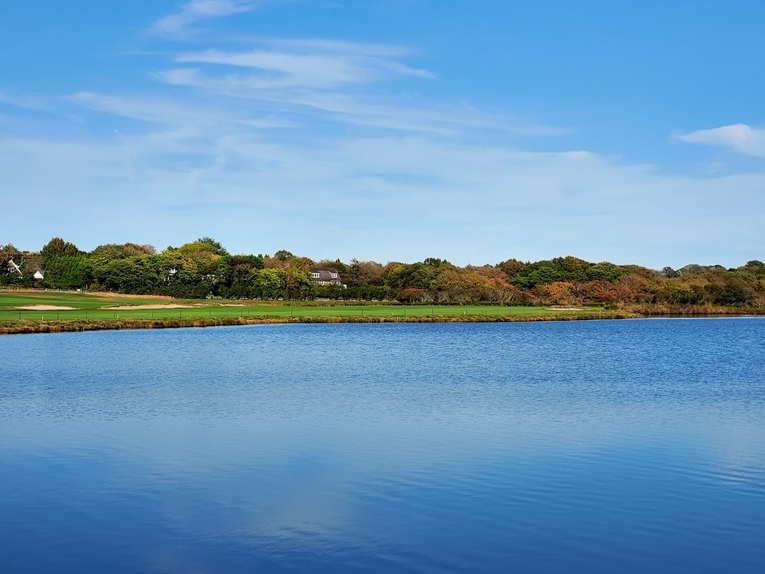
Downwind, the angle off the tee is just inside the far right bunker. Into the wind, the line is toward the bunkers seventy yards back and to the left.
Seventeenth hole, 330 yards; Maidstone’s design plays no favorites and just as the sixteenth swings left to right, the seventeenth swings right to left and represents the last of the heroic tee shots. As with the short seventh, the green is bunkered on the inside of the dogleg, thus making making an approach from the outside of the dogleg the oft times preferred angle. The green complex rivals the eighth at Pine Valley as one of the meanest and most exasperating in the country – the sub 4,000 square foot putting surface slopes fiercely back to front and the shoulders of the elevated green easily kick balls away, including out-of-bounds. Given the green’s proximity to a busy intersection (some grumble that it is in the intersection), the commotion of automobiles, bicyclists and pedestrians add to the strain and congratulations to the man who can pull off the exacting, nervy approach so late in the match. To the author, it represents a far greater test of poise and technique than a 470 yard bruiser as few holes in world golf come to mind as being so pugnacious yard for yard.
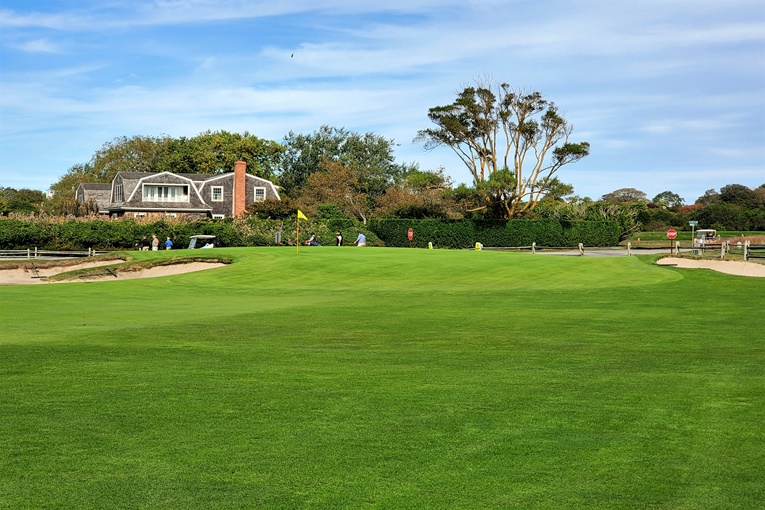
The ideal approach angle is from the outside of the dogleg. And even then, great care is required as ….
Eighteenth hole, 390 yards; Maidstone’s opening and closing holes deserve more recognition. Here, the finishing hole plays up the same hill that the opener plays down and the tee ball likely deadens into the upslope, making the hole play considerably longer than the scorecard suggests. Topography is one of the few things that Maidstone doesn’t throw at the golfer and yet, sure enough, when things might matter the most, here it is. The approach is played up a gradual incline to a horizon green, with a view of the Atlantic the reward as one approaches the green. Though your caddy will give the exact yardage, the day’s final approach is still an instinctual shot with the golfer needing to trust his eyes as to where the flag is located on the low profile green.

Fittingly, the final approach shot is to an horizon green with little aid provided for depth perception. Park knew golf to be a feel sport and that point is driven home at the last.
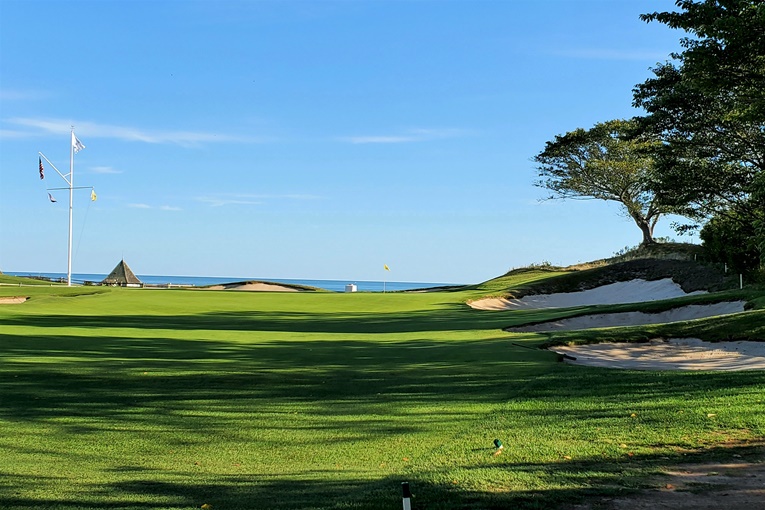
With the Atlantic in the distance, does the golfer have what it takes to run a shot onto the back plateau?
The author is blinded by Maidstone’s charms as its golf is ideal in all meaningful aspects, as we have just seen. Indeed, detractors have grown quiet since Coore & Crenshaw completed their work. They once mumbled that a 6,400 yard, par 72 course wasn’t long enough, especially when the wind is down and the fairways baked. In effect, their comment centered around the fact that three of the four par fives once measured under 500 yards and were vulnerable to the tiger. Since Coore & Crenshaw, and with the recent addition of a new tenth tee, the scorecard now reads nearly 6,800 yards. True, the fifteenth and sixteenth still measure under 500 yards but so what? Quibbling over whether the scorecard deems a hole to be a ‘4’ or a ‘5’ misses the point.
When Park laid out the course, match play was dominant to stroke play, with the sole object to beat the opponent’s score per hole. If conditions are such that one’s opponent cards a’4′ on a 480 yarder, then one needs to best figure how to do the same. This is no mean feat as the holes in question at Maidstone feature out-of-bounds, water hazards and/or bracken covered sand dunes, which penalize imprudent tactics with no remorse. Unlike many par fives in the United Kingdom which tolerate lazy play on the first two shots, the pressure is kept on the golfer at Maidstone.
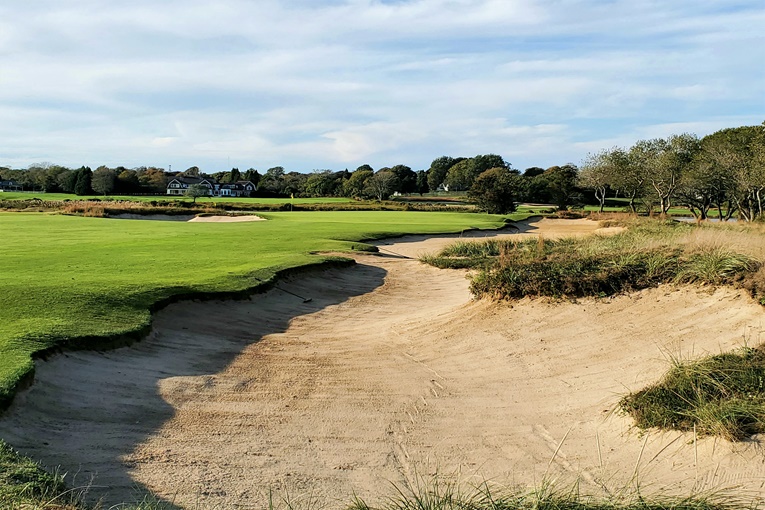
This sixty yard bunker down the right of the reachable par five 15th has left many a man with a far harder shot for an up and down birdie than he was originally anticipating when he went for the green in two.
On rainy Sundays, sometimes it is interesting to wonder which of his own courses an architect might most enjoy seeing today if he were still alive. While Willie Park Junior is closely associated with the historic Old Course at Sunningdale, and while he poured his heart (and money) into Huntercombe, how could a Scot like Park fail to select today’s Maidstone, where so much of the game’s original spirit and enjoyment is alive and well? Its playing angles, variety of obstacles and collection of greens are the work of two master architects, Park for building them and Coore & Crenshaw for dramatically revealing them. For those of us that think a round of golf should take three hours, and that the player should be equally taxed mentally and physically, Maidstone is a master class of design, one which any modern architect would do well to study intently. Afterall, Maidstone represents the progression of architecture in this country, from Dunn’s original effort to a Golden Age marvel to being caringly restored and augmented.
Located on the east end of Long Island, this family club is surrounded by world class golf. Generally a course of this magnitude would be the ‘best’ in the region but such is not the case. It is plenty of people’s ‘favorite’ but to call it the best would reflect undue bias. Still, New York is far and away the country’s best state for golf. Located elsewhere, Maidstone would be the best course in perhaps 45 states; it’s that ridiculously good.
The End


